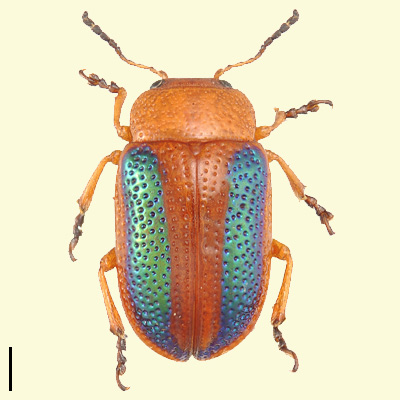
|
Calomela Hope |
|
Move cursor over image to view head |

|
|
Calomela parilis Lea
Scale bar equals 1 mm |
Species found in New South Wales: Calomela bartoni (Baly), C. crassicornis (F.), C. curtisi (Kirby), C. eyrei Blackburn, C. foveicollis (Baly), C. fugitiva Lea, C. fulvilabris (Germar), C. imperialis Blackburn, C. ioptera (Baly), C. jansoni (Baly), C. juncta Lea, C. maculicollis (Boisduval), C. pallida (Baly), C. parilis Lea, C. picticornis Lea, C. pulchella (Baly), C. regalis Lea, C. relicta Reid, C. ruficeps (Boisduval), C. vittata (Baly).
Description
Length: 4 - 11 mm; body shape variable, most species moderately narrow (length to width ratio > 1.8:1) and flat (length to height ratio > 2.6:1), but some (generally rainforest species) broad (length to width ratio < 1.8:1) and convex (length to height ratio ranges from 2:1 to 3.3:1).
Head: Contracted behind eyes; frons without vertical groove beside inner margin of eye; frontoclypeal suture strongly transverse, V shaped or rounded; first segment of maxillary palp ventrally convex, without sharp leading edge; apical segment of maxillary palp strongly expanded from base to truncate apex; apical margin of mentum truncate or shallowly concave.
Thorax: Pronotum broadest at middle or at base; anterior trichobothrium present ; posterior trichobothrium present; sides of pronotal disc with irregular punctate depression on each side, rarely with only scattered large punctures (eg C. jansoni); base of pronotum without margination; hypomeral groove present, curving from prosternal suture then parallel to pronotal margin, rarely shallow (C. relicta); anterior of prosternum without median or lateral ridges, midline not anteriorly produced; prosternal process narrow, longer than broad (but apex often bilobed or abruptly expanded), with basal right-angled lobes absent; procoxal cavity open, gap at least half width of procoxa; elytral tubercules absent; elytral striae usually present, rarely absent (but punctures longitudinally arranged), 5th stria deeper at base compared to adjacent striae, or not; elytra not extended vertically, epipleura entirely visible; base of elytra not overlapping basal angles of pronotum; epipleuron narrow, < 0.2 times width of elytron, without setae; anterior face of mesoventrite process rarely gradually raised, usually abruptly raised and convex or truncate, posterior margin truncate to strongly concave; metaventrite anterior femoral plates absent; metaventrite process not raised anteriorly; apices of mid and hind tibiae without row of short spines on distal surface; tibiae without obvious external keels; apex of third tarsal segment not or feebly bilobed; claws simple, or simply toothed or appendiculate with sharp basal tooth.
Abdomen: Pygidial groove absent; abdominal ventrites with or without patches of large setiferous punctures; apex of last ventrite strongly or shallowly excavate, or truncate, often with a pair of teeth, usually with median depression in male.
Distribution and biology
The genus Calomela occurs throughout Australia and is also present in New Guinea. In Australia there are about 45 species, at least 20 occurring in New South Wales (Selman 1976, 1977, 1979; Reid 1989, 1992). Most species are common where they occur.
Calomela species are particularly associated with Acacia and more than one species may occur on a single plant. For example, a small plantation of Acacia mearnsii near Queanbeyan included co-occuring populations of four species of Calomela (Hunt et. al. 1996). In most species, adults and larvae are leaf feeding but some adults prefer flowers. Host specificity appears to be rare, most Calomela species with recorded hosts have more than one host species (Reid 1989, 1992).
Notes
The concept of this genus has changed in recent years to include several other poorly distinguished genera (Daccordi 1994; Reid 2004). The species have similar biology where known.
References
Daccordi, M. 1994. Notes for phylogenetic study of Chrysomelinae, with descriptions of new taxa and a list of all the known genera (Coleoptera: Chrysomelidae, Chrysomelinae). pp. 60-84, in Furth, D. G. (ed.) Proceedings of the third international symposium on the Chrysomelidae, Beijing, 1992. Backhuys, Leiden.
Hunt, A. J., Gullan, P. J. & Reid, C. A. M. 1996. Chrysomelidae (Coleoptera) and other phytophagous insects in a plantation of black wattle, Acacia mearnsii De Wild., in southeastern Australia. Australian Journal of Entomology 35: 85-92.
Reid, C. A. M. 1989. A new species of Calomela Hope (Coleoptera: Chrysomelidae) from New South Wales, with habitat and distribution notes on other species in the genus. Australian entomological Magazine 16: 69-73.
Reid, C. A. M. 1992. Calomela nigripennis Lea, a valid species (Coleoptera: Chrysomelidae). Australian entomological Magazine 19(4): 125-132.
Reid, C. A. M. 2004. A taxonomic revision of the Australian Chrysomelinae, with a key to the genera (Coleoptera: Chrysomelidae). Zootaxa
Selman, B. J. 1976. Lamecola gen. n. (Coleoptera: Chrysomelidae) a genus new to Australia. Journal of natural History 10: 681-684.
Selman, B. J. 1977. A review of the genera Carystea Baly and Paralepta Baly (Coleoptera: Chrysomelidae). Australian Journal of Zoology 25: 133-145.
Selman, B. J. 1979. A reappraisal of the Australian species of the genus Calomela Hope (Coleoptera: Chrysomelidae). Australian Journal of Zoology 27: 561-584.

